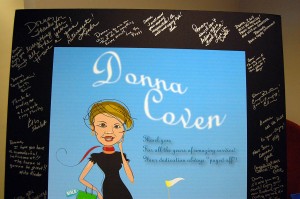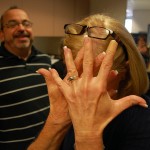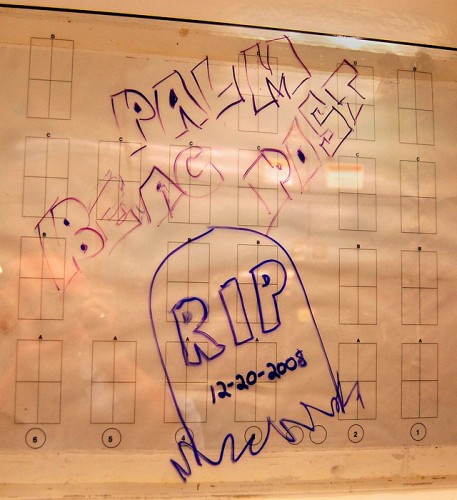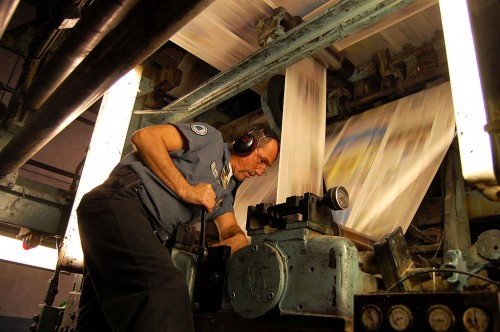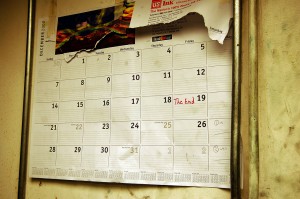Warning: graphic images ahead

Unfortunate ad placement is a fact of life. I’m sure the page designer would like to claw back this one showing a person with a computer strapped to his back, falling though the air like a parachute jumper. The ad happened to run on Sept. 17, 2001, next to a story about how IT departments were coping with the aftermath of September 11, when real people jumped out of the Twin Towers to keep from burning to death.
How well did my old paper do on the earthquake in Haiti?
I spent 35 years working for The Palm Beach Post. I never went to Haiti myself, but I sent photographers there when I was director of photography. I’m not exaggerating when I say that every shooter came back a changed person.
Lannis Waters, a photographer who had been to Haiti several times was one of the few old-timers to survive the buyouts. I heard a rumor that he was going back, so I turned to The Palm Beach Post web site to see if he had filed anything in the gallery of photos from the devastated island.
This goes beyond insenstive
Cops, journalists, healthcare workers and EMTs use gallows humor to protect us from what we see on a daily basis. We try hard, though, to keep that defense mechanism away from outsiders, who wouldn’t understand.
These advertisements paired with horrific pictures of crushed bodies, maimed children, destroyed homes and incredible human suffering were worse than any caption I ever saw posted on the photo department’s back bulletin board.
SECOND WARNING: GRAPHIC IMAGES AHEAD
I couldn’t decide which was worse

The Jet Blue ad that says, “THIS DAY JUST KEEPS GETTING BETTER” next to a father who has just discovered his 10-month-old daughter in a pile of corpses.

A Palm Beach Post house ad with the headline “SURVIVING THE SQUEEZE” next to a photo of a pair of feet sticking out from under a collapsed hotel.

Another Palm Beach Post house ad headlined, “LOSING YOUR HOME?” next to a photo of the rubble of Haiti’s Presidential Palace.
Airlines used to kill ads
Commercial airlines used to have a mandatory kill in their contracts to keep one of their ads from running on the same day as a plane crash. I’m sure that some of these advertisers would be appalled to see their ads used next to these photos. Under any other circumstances, the juxtapositions would be funny. This isn’t one of them.
My geek son gave this explanation:
I think this is less about good decisions and more about the technology they use and the inability to make a change that detailed. I believe the Post outsources its ad space to Yahoo. If this is the case, Yahoo would be the ones feeding the white space and the Post has no control over it. The same is the case for website ads driven by Google.
A web developement person agreed
A web development person who is a (former?) friend said essentially the same thing:
… the technology probably does exist to eliminate certain ads in theory based on keywords (like say not having Jet Blue ads next to photos of a plane crash), but might not be available in the current configuration (maybe because of Yahoo, maybe because of something else), or maybe it doesn’t work as specifically & focused as you’re asking for, and it definitely isn’t feasible to just “turn off” ads on a photo gallery because there just isn’t an easy button like that, not to mention that the photogalleries are yielded by a 3rd party, and ooh I can’t wait to hear your rant about how we shouldn’t outsource our photogallery tool.
Possible solutions?
- Kill the ad feed for a few days?
- Pull the ads out of rotation (some photos must lack ads because they displayed plain black where the ad would have been)
- Run APPROPRIATE house ads detailing how you are covering the event
- Run public service announcements
Technology has come a long way
I worked at a paper in North Carolina where the publisher had a bell that would ring in his office when the presses started to roll. He expected department managers or a substitute to be in the press room.
He would hand them out, warning, “Read for content, not entertainment.”
If he found something he didn’t like, he’d start with the pressman and work his way upstream to the editor until he found someone accountable for what displeased him. I can’t imagine D.R. Segal accepting the answer, “It’s beyond our control.”
I’m waiting for a Post response
I sent an email to three of the top execs at The Palm Beach Post at 11:43 A.M. on January 15. If I get a response, I’ll post it here as an update.
Gallery of Photos
Here is a representative sampling of the photos and ads. I could have included more, particularly the house ads, but I didn’t have the stomach for it.
[Note: Ken Steinhoff’s first published picture was April 18, 1963. He’s worked for papers in four states as a reporter, copy editor, photographer, typesetter and engraver. He was hired as a photographer for The Palm Beach Post and Evening Times Dec. 31, 1972. He was a shooter for three years, promoted to director of photography and spent from 1991 to his retirement in 2008 as telecommunications manager. He wrote this piece as a long-time Palm Beach Post subscriber who remembers when newspapers were accountable for every word they published.]


